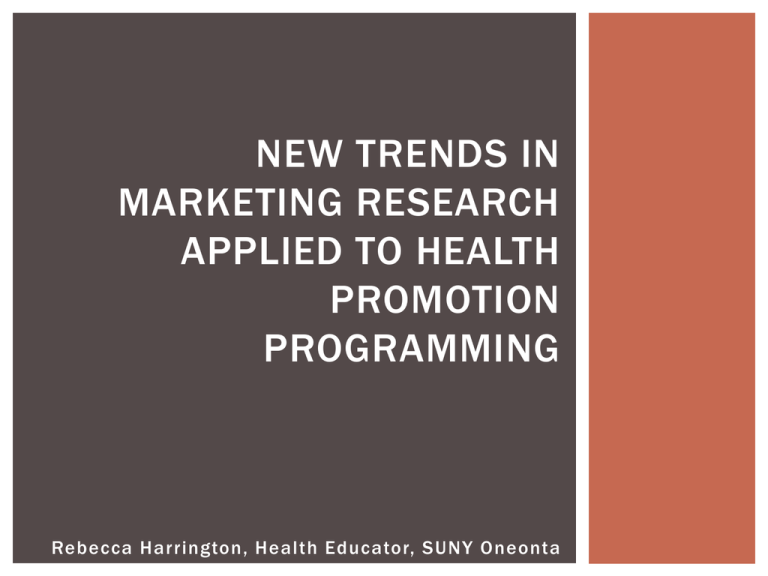
NEW TRENDS IN
MARKETING RESEARCH
APPLIED TO HEALTH
PROMOTION
PROGRAMMING
Rebecca Harrington, Health Educator, SUNY Oneonta
DEFINE BRANDING
RESEARCH CONCEPTS
branding
brand
per sonality
entity
theorists
incremental
theorists
WANT TO FEEL SEXY?
Nov 17, 2010
Glamorous
Feminine
Good-looking
Intelligent
IMPLICIT THEORY OF SELF
Entity
Theorists
More likely to believe in fixed traits
Need “brand personalities” to fix
flaws
Will seek out products to make you
feel a certain way about yourself
Use brands to signal their qualities to
others
If you’re the kind of person who thinks
a particular brand will make you more
______, then it will.
Incremental
Theorists
More likely to believe in
malleable traits
More likely to not care so
much about brand.
If you don’t feel that way about the
brands you buy, you won’t feel the
effects.
YOU ARE CURRENTLY WONDERING WHAT
YOU ARE, AREN’T YOU?
Strongly
Agree
Agree
Mostly
Agree
Mostly
Disagree
Disagree
Strongly
Disagree
The kind of person someone is, is
something very basic about them and
it can’t be changed very much.
1
2
3
4
5
6
People can do things differently, but
the important parts of who they are
can’t really be changed.
1
2
3
4
5
6
Everyone is a certain kind of person
and there is not much that can be
done to really change that.
1
2
3
4
5
6
Calculate your average.
4.0 or higher is classified as incremental theorists
3.0 or lower is classified as entity theorists
Usually about 15% go unclassified, rest of population is evenly split.
THE CLOWN ON THE UNICYCLE
“Did you see anything unusual?”
Listening to music or walking alone (32%)
Walking with a friend (60%)
Talking on cell phone (8%)
“Did you see the unicycling clown?”
Listening to music (61%)
Walking alone (51%):
Walking with a friend (71%)
Talking on cell phone (25%)
WHAT THEN IS “BRANDING?”
Branding:
Is strategic
A communication of the
characteristics, values
& attribute that clarify
what a par ticular brand
is or is not-what sets
you apar t from
competitors
Keeps you coming back
BRAND PERSONALIT Y
A set of human characteristics associated with a brand.
Tend to be enduring and distinct
Capable of driving consumer preference
BRAND MANAGEMENT
How do you get people to associate feelings/traits with your
brand? How do you want others to classify it?
If you are a new brand, consumers will try to fit you in with
what they already know.
If a high school student only heard abstinence only messages,
they will assume that’s the only kind of messages they will hear
from health professionals.
WHAT BRAND DO YOU USE TO:
Increase excitement?
Decrease anxiety?
Wind down to?
THINKING ABOUT HOW WE BRAND
OURSELVES
What kind of music do you play?
We communicate based on our brand choices:
•
Are you an Apple or PC/Android?
•
Are you a Coke or a Pepsi?
And with our decisions-particularly with our
students:
•
Are you sexually active?
•
Do you drink?
•
What are the social consequences of being
associated with the “out groups”.
MARKETING
Marketing:
Ever ything that communicates
anything about a business to a
customer. A brand is par t of a
marketing strategy.
Is tactical
Gets you to buy
Will your brand make
consumers feel good?
We make decisions based on
how we can perceive that
decision af fecting our future
feelings (buy food now
because I will be hungr y later)
NEUROMARKETING
Term first coined in 2002, fairly new field of study
Frequently involves the use of the fMRI, allows us to see what
parts of the brain are active while the person performs a
thinking task.
Allows us to measure living brains in action
Can be defined as an overlap of neuroscience and marketing.
As a field of study it looks at how brains will respond to
marketing techniques.
NEUROPSYCHOLOGY &
MARKETING
EEG
fMRI
Neural
focus
group
MEASURING THE BRAIN-EEG
Discovered in 1929
Electrodes are placed on scalp
Measure the electrical activity when groups of neurons fire up
to 2000 times per second
Can capture a brain response in milliseconds
Does not measure the deeper brain (beneath the cortex).
MEASURING THE BRAIN-fMRI
Measures the increase in oxygen levels in the flow of blood
Indicates when activity in a certain area of the brain is
increased (baseline is collected, than stimulus)
Measuring emotional response in real time.
Emotions are being seen in a new light (how they af fect
attention)
Costs are in the many millions
Can take up to 5 seconds for the additional blood supply to
reach a region of the brain.
Low levels of arousal deliver less electronic activity
OTHER MEASURES
Eye tracking-simple and cheap to implement and can show us
where focus goes.
YOUR BRAIN & MOUTH THINK
DIFFERENTLY
Traditional Focus groups
can capture facts and relate what the conscious mind captured .
The process of accessing stored information and turning it into a
physical response (verbal) that the brain alters the data.
Not so good at finding how a consumer really felt about a specific
product or how well they remembered something (what the
unconscious mind captured)
Neural Focus Groups
Require about 10% of the subjects that traditional focus groups
would use-are brains as humans are rather alike
“…the study suggests that the neurological reactions of a few –
reactions that people are not even consciously aware of, and that
differ from the opinions they express – can predict the responses of
many other people to ad campaigns promoting specific behaviors.”
Buyology, Martin Lindstrom
WHAT BRAINWAVES CAN TELL US
Brainwaves can tell us what we can’t convey verbally.
THE FAMOUS PEPSI CHALLENGE
Read Montague, published in 2004
N=67; brain scanned while given the
Pepsi challenge
half chose Pepsi (tended to light up
brain region related to feelings of reward
they were told they had chosen Cokechanged the brain activity to regions
associated with memory.
in theory Pepsi should have 50% of the
market share based on the taste test.
consumers are choosing Coke for
reasons less related to taste preference
and more for their experience with the
Coke brand.
THE AMAZING BRAIN
Sitting comfortably in a chair your
body is consuming energy at
roughly 100 watts an hour, about
the same as the average light bulb.
Your brain consumes about a fifth
of that.
In current electricity charges, that’s
less than a quarter a day to
operate!
Ef ficiency
Female vs
male
YOUR BRAIN
Our senses take in 11 million bits of information every second.
Conscious brain can handle about 40 bits of info/second
How do you get a brain to pay attention to your “bit”
Brain is capable of 200 million billion calculations/second
People do not have access to all of the sources of their
decisions and behaviors -they can’t tell someone why they do
what they do.
3% of the body’s weight,
uses 20% of the energy
INTERESTING BRAIN PHENOMENA
The brain know what it knows as fast as producing the
knowledge itself
e.g. I know the answer, give me a minute.
Health Ed Takeaway: You know when you’ve seen something
before, so cueing people to your message works. Once you’ve
seen a commercial you don’t need to see the whole thing again,
just a fraction of it will cue you to the product & message
SUPER EFFICIENT BRAIN COMPUTER
The brain is going to do what is most ef ficient in terms of
processing.
This relates to why people won’t likely lie on a survey -it takes
more energy to make something up (story telling) than to tell
the truth (recall).
PEER ED LOGO CHANGE
“When it makes a decision on
which direction to fly the fruit
fly will have many options. It
needs to consider some of
these and decide on one. The
best guideline is to decide
which direction would make it
feel the best. Generally that
would mean towards
something that it recognizes
as food, or as sex, or it might
simply be a sunny spot….”
Eric DuPlessis,
The Branded Mind
MALE VS FEMALE BRAIN
When anticipating uncertain rewards:
women activate the brain regions associated with processing
emotions-this is greater during the follicular phase then during the
luteal phase.
Men activate a brain region involved in motivation for receiving
rewards.
In stressful situations (count backwards from 1000 by 13s):
Women-emotional responses
Men-fight or flight
Study of cheaters/non-cheaters getting a shock
Regions of brain associated with empathy light up when non -cheater
is injured
Cheaters-males’ reward center lit up; women less empathy
MORE ON THE FEMALE BRAIN
More empathetic skills (evolutionarily as a result of spending
time with babies).
Female brain is hard wired to:
seek out community
engage with faces (direct eye contact is good)
respond positively to women in groups enjoying a shared activity
and babies
Female brains are designed to multi -task
more right-left brain connection than male brain
*ostracism from the group is a dangerous consequence
GETTING ATTENTION
You don’t have to be the biggest
and the loudest.
You just need to connect up with
something already there
Naturally we will pay attention of
the most dominant thought in your
brain.
If you have to use the bathroom
right now, or are really hungry you
aren’t going to absorb this
information.
When you are relaxed you are more
likely to remember.
Are we reaching students when
they are relaxed? When is that?
GETTING THE BRAIN TO TAKE NOTICE
What will get our attention?
loud & big, clean & clear
connection to an emotional memory
a solution to a current or future problem
(what you need is here)
addresses a current mood
current level of brain arousal
Brain Turn Of fs
Tasks that take a long time to resolve
Clutter
Messages that don’t apply
Beware: scare tactic advertising
(inducing stress) can change what part of
the brain is responding to the message tread carefully.
GETTING ATTENTION
“touching” the consumer
packaging & design
advertisement
sponsorship
viral social media
Ads that evoke positive emotions have more motivational
power (think beer ads)
Most marketing activities get little attention
Sometime the attention they get is not good.
#McDStories (tweetjacking)
EMOTIONS
Feelings
Thoughts
Behaviors
WHAT HAS NEUROSCIENCE CONTRIBUTED?
The importance of emotions in creating attention
Role of feeling in brand choice
Measure arousal levels when people watch advertisements
FEELINGS
What neuromarketing of fers us is a chance to explore
the role of feelings in our decision making process.
Will our decisions affect our state of homeostasis?
Will our decisions affect our emotions (state of
environment)?
will our decisions affect our moods (state of brain)?
Everybody knows what feelings are, until asked to explain
what they are.
Am I running away from the bear because I am afraid or am I
afraid because I am running away from a bear.
BEHAVIOR & FUTURE THINKING
Humans can make decisions based on how they perceive that
decision will af fect their future feelings.
“I might get hungry later so I will bring a snack”
A major objective of marketing is making sure their brand will
make consumers feel good.
HOMEOSTASIS
People use brands to return to their
bodily state to a balance where they feel
comfortable.
“[this snack] really satisfies you”
Treading on Maslow’s territory here.
Issue here: a homeostatic system is a
negative feedback system. It does not tell
you when it is feeling good, it tells you
something is wrong, it feels bad and
something should be done about it.
People buy stuf f in anticipation of
future homeostatic states and this
influences our attention.
(I’ll be tired, cold, hungry….)
DON’T FORGET THE DOPAMINE
A major function of advertising is to create
memories of dopamine moments and keep
those moments fresh.
1. Pleasant things that actually happened
to you as a result of the brand or when
that brand was present.
2. Pleasant things that happened to you,
not as a result of the brand or it’s
presence, but you think might have
happened as a result of the brand being
there (an implanted memory)
3. Pleasant things that might have
happened to you
4. Pleasant things that will happen to you if
the brand is there.
MIRROR NEURONS
Interaction with objects
Empathy (fan behavior)
video
IN SUMMARY
Your brain records what things are and how it makes you feel
WHAT DO BRAINS LIKE?
Fonts
Colors
Images
Novelty
FONT CHOICE
Sans Serif Serif
vs
Code words: Sans serif=gothic, serif=roman
PANTONE
Color forecast
NOVELT Y
Simple san serif font
Play on word “know/no”
Colors that connect with dv/ sa
IMAGES
Faces-the brain likes faces and is capable of seeing them in
other objects (eye contact is good)
Placement to left with text to right helps the brain (right
brain/left brain stuf f)
IMPLICATIONS FOR
SOCIAL NORMS
& OTHER BITS THAT
REBECCA FOUND
INTERESTING
HOW WE PROCESS NUMBERS
Percentages vs absolute numbers
People believed cancer to be 32% riskier when told it kills 1,286 out
of every 10,000 people vs 12.86% of people.
The number implies real people
Use real numbers for impact
Use percentages for negative data
BLINDNESS
ANCHORS
What we think something costs. Think the Price is
Right…how much is that refrigerator worth.
USE MONEY CUES WISELY
Which restaurant menu style is likely to cause you to
spend more money:
$12.00
12
Twelve dollars
It’s actually choice b. It is visually the smallest.
If you are considering utilizing a campaign slogan that attaches an idea of currency
or uses currency symbols keep in mind that:
•
Currency symbols trigger feelings of selfishness and self indulgence
•
So do not use them in campaigns that are targeted towards giving & caring.
DECOYS
If you are offering several choices, purposely have one that is
good, but not as good as the others. It will drive more people to
the better deal.
The experiment:
First round: $59 internet only subscription or $125 internet &
print
Second round: added option of print only $125.
In round one: 68 people chose internet; 32 chose internet
& print
In round two: 16 chose internet; 0 choose print; 84 chose
internet & print
fMRI scanning found that brains choosing between two
attractive offers displayed irritation due to the difficulty of
choosing. The less attractive option makes the choice
process easier.
THE SENSES
One fourth of the brain is involved in
visual processing
70% of the body’s sense receptors are
in our eyes
Memory peak for visual memories-15 to
30 years old
Message: don’t use words when an
image can suffice
Smells are mainlined directly into our
centers for emotion and memory
1% of brain is devoted to smell
Peak smell ability is from 5 to 10 years
old-why you associate so many smells
with child hood.
QUESTIONS
SUGGESTED READING
BOOKS REFERENCED
Brainfluence: 100 Ways to Persuade And Convince Consumers
with Neuromarketing by Roger Dooley
The Branded Mind by Erik DuPlessis
The Buying Brain by Dr. A .K. Pradeep
Why We Buy by Paco Underhill
Buy -ology by Martin Lindstrom
Brandsense by Martin Lindstrom
Final slide presentation available at:
www.Oneonta.edu/development/wellness/presentation
s/newtrends.pptx









